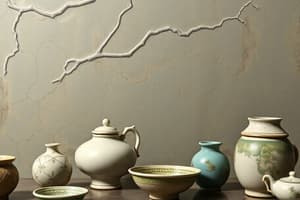Podcast
Questions and Answers
Which characteristic feature is common to ceramics?
Which characteristic feature is common to ceramics?
- Brittle and hard (correct)
- Conductive to heat
- Low melting point
- Soft and ductile
What is the primary component of traditional vitreous ceramics?
What is the primary component of traditional vitreous ceramics?
- Nitrides
- Oxides
- Silica (correct)
- Metals
Which material is considered a high-performance ceramic used for cutting tools and wear-resistant parts?
Which material is considered a high-performance ceramic used for cutting tools and wear-resistant parts?
- Diamond-like carbon (DLC)
- Concrete
- $Al_2O_3$ (dense alumina) (correct)
- Graphite
What is the key component of cement according to the provided information?
What is the key component of cement according to the provided information?
Which type of ceramics offers huge possibilities of influencing electronic structure to obtain semiconductive or superconductive properties?
Which type of ceramics offers huge possibilities of influencing electronic structure to obtain semiconductive or superconductive properties?
What is the primary binding mechanism in predominantly covalent ceramics?
What is the primary binding mechanism in predominantly covalent ceramics?
Which of the following properties is NOT typically associated with ceramics?
Which of the following properties is NOT typically associated with ceramics?
What is the classical approach to forming ceramics involving powders?
What is the classical approach to forming ceramics involving powders?
Which process involves the simultaneous application of pressure and temperature to achieve higher densities and smaller grains in sintered ceramics?
Which process involves the simultaneous application of pressure and temperature to achieve higher densities and smaller grains in sintered ceramics?
How are ceramic layers typically formed in Chemical Vapor Deposition (CVD) or Physical Vapor Deposition (PVD) processes?
How are ceramic layers typically formed in Chemical Vapor Deposition (CVD) or Physical Vapor Deposition (PVD) processes?
What is the primary purpose of additives in the sintering process of ceramics?
What is the primary purpose of additives in the sintering process of ceramics?
In which stage of sintering do bridges between particles form, leading to a decrease in pores and an increase in density?
In which stage of sintering do bridges between particles form, leading to a decrease in pores and an increase in density?
Which method of forming ceramics involves the simultaneous application of pressure and temperature to achieve higher densities and smaller grains in sintered ceramics?
Which method of forming ceramics involves the simultaneous application of pressure and temperature to achieve higher densities and smaller grains in sintered ceramics?
What is the primary characteristic feature associated with ceramics?
What is the primary characteristic feature associated with ceramics?
Which type of ceramics predominantly involves ionic bonding and offers huge possibilities of influencing electronic structure to obtain semiconductive or superconductive properties?
Which type of ceramics predominantly involves ionic bonding and offers huge possibilities of influencing electronic structure to obtain semiconductive or superconductive properties?
What is the primary reason for the high melting point of ceramics?
What is the primary reason for the high melting point of ceramics?
Which type of ceramics is commonly used for cutting tools and wear-resistant parts?
Which type of ceramics is commonly used for cutting tools and wear-resistant parts?
What is the primary component that sets in cement when mixed with water?
What is the primary component that sets in cement when mixed with water?
Which characteristic is NOT commonly associated with ceramics?
Which characteristic is NOT commonly associated with ceramics?
What type of ceramics offers the possibility of influencing electronic structure to obtain semiconductive or superconductive properties?
What type of ceramics offers the possibility of influencing electronic structure to obtain semiconductive or superconductive properties?
Flashcards are hidden until you start studying
Study Notes
- Dr. Janusz Bucki delivered a lecture on ceramics and glasses at Wołoska 141, room 308, Warsaw.
- Ceramics are obtained by combining one or more metallic elements with nonmetallic elements, resulting in a dark-colored material.
- Ceramics include oxides, nitrides, carbides, and one non-metallic element like diamond or graphite.
- Ceramics have hard, brittle properties, high melting points, and are stable in many environments. Most are not electrical or heat conductive.
- Ceramics come in two main types: traditional vitreous ceramics used for plates, cups, sanitary wares, etc., and high-performance ceramics used for cutting tools, dies, engine parts, etc.
- Ionic ceramics are formed by the electrostatic attraction between ions, resulting in a dense packing of ions in the crystalline network.
- Covalent ceramics are formed when atoms bond by sharing electrons with their neighbors.
- Ceramics have several desirable properties including low density, temperature resistance, high hardness, and high compression strength. However, they are also brittle, have low plasticity, and low resistance to mechanical vibration.
- Forming ceramics involves the classical approach of pressing and sintering powder, hot pressing, or isostatic hot pressing for higher densities and smaller grains. Additives like MgO can be used to improve sintering and reach full density.
- Other common methods of forming ceramics include reaction bonding, extrusion, slip casting, tape casting, and injection molding.
- Ceramics can be formed by chemical vapor deposition (CVD) or physical vapor deposition (PVD) processes.
- Ceramics go through several stages during sintering: distribution of particles after pressing, decrease in distance between particles, formation of bridges between particles, and growth of particles.
- Technical ceramics are produced from powders.
Studying That Suits You
Use AI to generate personalized quizzes and flashcards to suit your learning preferences.




